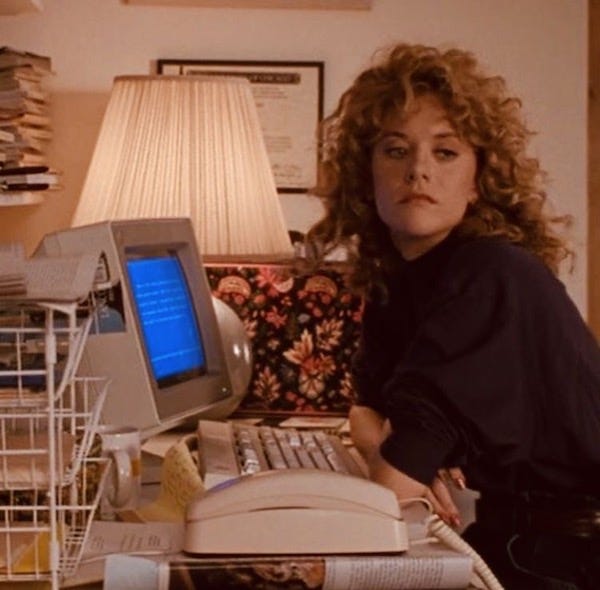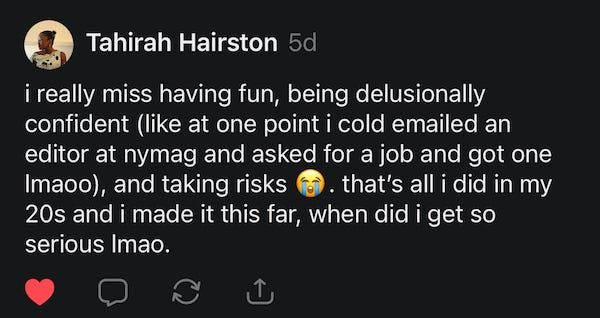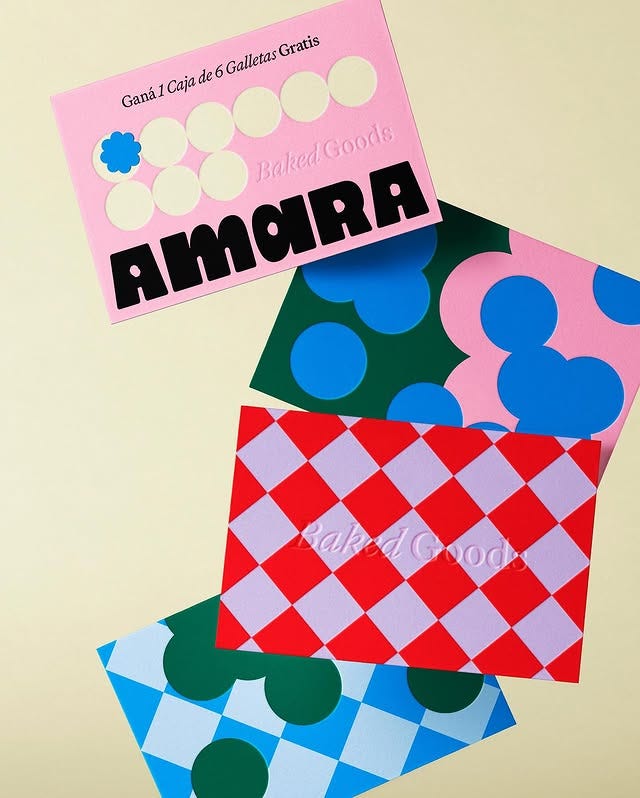A cold email is not and never will be a cover letter. In a cover letter your only goal is to sell yourself. When you send a cold email, you’re trying to accomplish two things. One, is if this particular client is in need of outsourced help. Two, introducing yourself. That’s all. You’re not going to include any fancy attachments, because again, you’re not trying to sell yourself - yet.
The perfect length of a cold email should be no more than 2 short paragraphs. No one reads past a third paragraph, some might, but I think if you let yourself believe that less is more, you then leave the reader wanting to know more about you and your skillset.
My very first cold email was to Dany Levy, the founder of DailyCandy. Raise your hand if that name brings back fond memories of sample sales, and life before direct to consumer. The way I decided to email her was pure happenstance. One night a friend and I had stopped into this casual restaurant somewhere on 1st Ave, East Village (long gone, can’t even remember the name) and there was a large party of eight or so girls. Dany was at the head of the table, she stood up to make some kind of informal speech accompanied by a toast. They were celebrating something. As my friend and I were on a waiting list to be seated, I couldn’t help but stare at the group. Then, it hit me who she was and I excitedly tugged at my friend’s elbow. I said, that’s Dany Levy and went on to explain that I had just read about her in The New York Times. In fact, I had cut out the article and tacked it onto my bulletin board (vision board for gen z’ers). This was peak DailyCandy when they had launched in other cities. Naturally, I convinced myself that this was in fact kismet and that I had to go and talk to her at some point in the evening. My friend, of course, said that it would not be a good idea to interrupt their work dinner. Thankfully, she was right, but after reading about her in the paper, already a fangirl of DailyCandy, she was in my eyes a local celebrity. My friend couldn’t commit to the 45 minute wait for a table, so as we were about to leave something caught my eye. On the hostess stand was a clear fishbowl jar filled to the brim with random business cards. Nearest the top was a familiar illustration against a clean white card stock. I walked up closer to the fishbowl as one does if they were actually peering into a real fishbowl and the card read DailyCandy, underneath was Dany Levy, Founder. Beneath it was her email. I memorized it by heart (it was just dany@dailycandy) all the while my friend was already pulling me out the door. (Now looking back, wasn’t the point of dropping your card into the potluck jar a free lunch or something? Love that for Dany)
I emailed her that night. No, just kidding, this was before email scheduling, I wasn’t going to be that weirdo who emails past 11pm. The next morning, I sat down at my desk and formulated what I thought was to be part of my fate in life. This was me attempting to make something of myself. My email was simple and to the point. I briefly touched upon the feature in The NY Times and that I’ve been a subscriber since the beginning. Told her what I was studying, that my interests were writing, fashion and contemporary literature (cringe!) and if there were any summer internships available at DailyCandy. Mind you it was already May and most of the valuable summer internships in the city were no longer available. Yet there I was, emailing the founder of a media start-up if I can work for a pittance. I ended the email with a ‘hope to hear from you soon, but if not I’ll follow up next week.’ Can I get a mic drop for that?
Dany replied two days later. No cc’s on the email, it was just me and her sharing an intimate moment in cyberspace. She was kind, gracious and also to the point. No, the summer internships program had already closed and they weren’t hiring for part-time positions either. There was no invitation to submit a resume for any future openings, instead included a link to their ‘now hiring’ page and that I should check back in the next few months. Then she thanked me again for reaching out and being a long-time reader. And that was the beginning of me making something of myself, in a way.
I always loved sending cold emails, more than I did emailing cover letters. There’s something so disguised in writing a cover letter, you’re basically saying the things you know the hiring manager wants to hear. And I don’t believe anyone truly stands out in a cover letter. Every freelancer knows how much time and effort it takes to send out cold emails. It gets easier and better with time and consistency. Recently I guided a friend new to the freelance world, who was in much need of tips on how to construct a good, non-boring cold email to a potential client without sounding desperate, pretentious and brand-new to the game.
There is no perfect way to write a cold email, because unlike a cover letter, you want to make it personal and professional.
THE SUBJECT LINE IS YOUR FOOT IN THE DOOR
Consider this your hurdle. It is the toughest part of composing a cold email. What is the least amount of eye-grabbing words that will guarantee a click to open. It should never read like a clickbait and you are not selling anything. You don’t want to risk it being delivered into the spam folder. The subject title should never ask a question. Ie; “Does Your Business Need a New Website?” Spam. The subject title should never sound bossy. Ie; “Book A Call To ” blah blah…
State what you’re offering. Ie; “Graphic Design Pitch for [Brand]”. Keep it simple, short and curious to know more. For freelancers, if you include ‘pitch’ in the subject title, it’s more likely to be opened, because this already implies the reason for your email. Clients - busy clients, like knowing what your agenda is.
A LITTLE FLATTERY NEVER HURTS
I stopped using the generic formality, ‘hope this finds you well,’ because it doesn’t sound authentic and you’re not Jane Austen. Yes, it’s a decent thing to say, but as a first impression it’s pretty droll and too basic. I like to start off by telling them how I came across them and where and what drew me to the brand. That shows you’ve done a little bit of homework prior to reaching out. Add in another sentiment of what you like about their service, product, etc.. Done, don’t overdo it.
BEST INTENTIONS
This is the center meat of the email, where you get to state what your expertise is and how you think it could help their business. You never imply that anything is actually wrong with their brand, but you make subtle hints that you have ideas on how to, whatever. Focus on the word ideas. That’s what your intention is for them at this early stage. This is where the client gets intrigued to learn more. Even if they’re working with someone else on a similar thing, the client is always starving for more ideas to be brought to them. But you never actually express what the ideas are in the cold email.
NAME DROP (OPTIONAL)
Depending on what it is you’re pitching, naming past clients can help to encourage interest and validity. You can also drop your website/portfolio link.
END IT WITH A CALL TO ACTION
Be gracious for their time, express that you’re very interested in scheduling a call and that you’ll follow up next week.
Listen, I myself was never taught on how to compose such an email. I was in an international pen pal club by age six, writing to strangers just comes natural to me. If you need a refresher or starting out as a freelance virgin, this is what I’ve always stuck to and it’s worked out for me.
〰️ linked in 〰️
While we’re on the topic, remind me again why the U.S. govt is so scaredy cat of China? Clearly this shows we have absolutely nothing worth stealing, America is so behind.
And a topic adjacent to China, Condé Nast is finally launching an influencer shopping platform. I briefly worked w/a client based in China who was interested in launching this in the U.S. market, this was like 7yrs ago, but as you can imagine there were many roadblocks back then. Influencers in Asia have had digital storefronts since the dawn of apps, it was fun researching them when I worked with that client. Why it took Condé Nast so long to realize this as a money maker - that’s American business for you. I don’t know how fruitful it will be under Condé Nast. These days anyone can open a TikTok shop with readymade consumers and algorithms. Why they would make this solely as an influencer program sounds very 10yrs ago to me. My guess is that their angle will be with luxury brands, a way to appease their advertisers since Vogue will no longer be a monthly. Also, I think the term influencer is rather Old Testament. If I saw that word in a business model I’d walk away.
〰️ now hiring 〰️
Are you hiring?
〰️ 5 good things 〰️
This content creator reads her grandmother’s diary entries from 1950’s in Manhattan, a true muse for Dear City Girl 💕
The way Adolescence sweeped at the Emmy’s and Stephen Graham’s speech is a reminder that there is never a hierarchy in creative collaborations.
This unlocked short fiction piece by Otessa Moshfegh in The Paris Review
My sweater of the season will need to be red. I came across an image of Alexa Chung in a bright red sweater and now it’s the look I want. This J.Crew cashmere crewneck is under consideration.
Finally, someone made Anna Wintour smile. (She can write a perfect cold email)
DNAMAG
Thanks for reading this post and being a subscriber to our growing community! If you enjoyed it please click the like button at the bottom - it helps to get discovered by new readers. ❤️
*DNAMAG uses affiliate links, and we may earn commission for any sales from affiliate links. It helps pay our writers.






